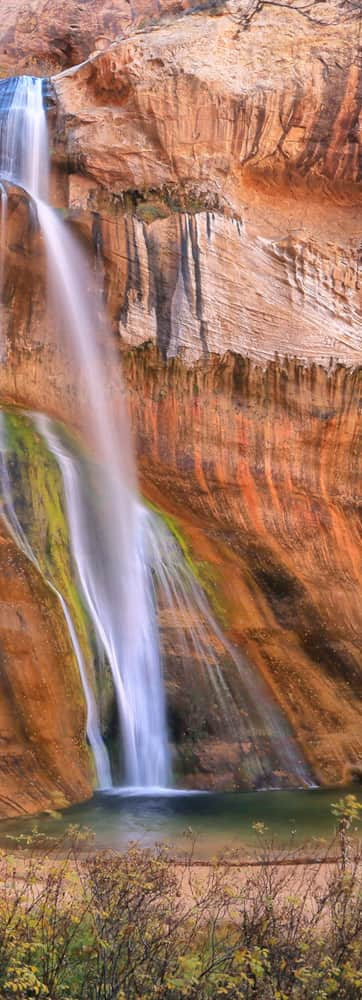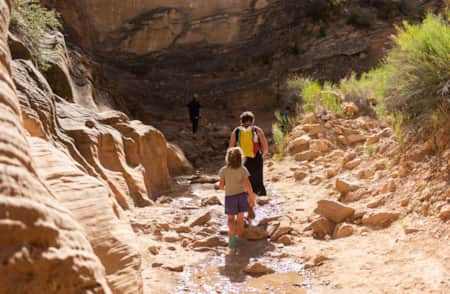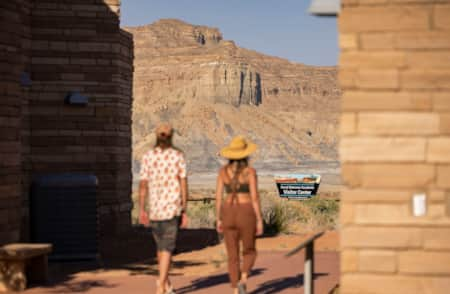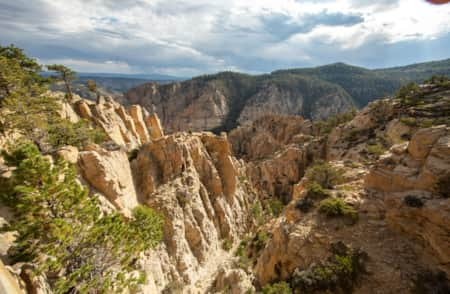
Escalante Canyons
Location
The canyons are in south-central Utah, north and west of the Glen Canyon National Recreation Area and Lake Powell. Accessed from Escalante or Boulder, Escalante Canyons is in the northeastern section of the Grand Staircase area.
Geography and Geology
The Escalante Canyons in the northern reaches of the monument begin as modest draws draining the flanks of Boulder Mountain. This lofty volcanic tableland bounds the river basin to the north and northwest. Drainages begin on the broad terrace traversed by Hole-in-the-Rock Road, gradually approaching the Escalante River. Once these drainages carve routes into the resistant Navajo Sandstone, they quickly develop into a network of slickrock gorges that are the myriad veins feeding the main artery of the river. Particularly in the upper Escalante Canyons, just below Boulder Mountain, the slickrock gorges emerge so suddenly and with such profound dimensions that it is an unrivaled scene of visual inspiration on the Colorado Plateau.
Navajo Sandstone is the predominant rock formation in the Escalante Canyons. Erosion has exhumed these ancient dunes and sculpted the resistant cross-bedded slickrock into a vast landscape of domes incised with innumerable serpentine canyons. This chiseled land is a true work of natural art and an unforgettable sight.
Visitor Centers and Entrances
The area has no official entrances, but several visitor centers surround the monument(s). The main visitor center for the Escalante Canyons section is the Escalante Interagency Visitor Center. The visitor center offers Escalante Canyon maps, great interpretive displays, and helpful staff members to answer questions.
A smaller but exciting visitor center on the north side of the monument is in Cannonville. The Big Water Visitor Center and Dinosaur Museum is an excellent stop on the south side of the monument when visiting Lake Powell, Antelope Canyon and Glen Canyon Dam or hiking one of the numerous trails located within the Grand Staircase region. Learn more about visitor centers.
Where to Stay
Overnight options: Book hotels, motels, lodges and bed and breakfasts in Escalante and Boulder to the north and in other small towns around the monument. Established campgrounds inside the Escalante Canyons section of the monument are Calf Creek Campground and Deer Creek Campground – both are great places to spend a night or two. Find additional camping opportunities at Kodachrome State Park and Escalante Petrified Forest State Park. Primitive camping is also allowed in the monument (try to use established areas). Glamping accommodations are available at Ofland Escalante.
Nearest groceries and supplies: Various small towns surround the monument. Escalante to the north offers visitor services.
Climate and Weather
Visitors come year-round to the Grand Staircase–Escalante National Monument region, but most come during spring and autumn. Since the region is a desert environment with daytime high temperatures often reaching 95 to 105 degrees Fahrenheit almost daily from June through August, summer is the least favorable time for hiking and visiting hikers.
Escalante, Utah, spring weather (March through May) varies, with daytime high temperatures ranging from the 50s to the 70s and nighttime lows ranging from 20 to 50 degrees. Occasional cold air fronts from the west and northwest can bring cold, windy conditions, rain showers in the lower elevations, and perhaps snow on the higher mesas, particularly in March and April. Generally warm, dry weather prevails between storm systems.
Autumn provides some of the most stable weather of the year. Clear, warm, sunny days and cool nights make this one of the most delightful seasons to visit the Grand Staircase-Escalante region. Expect daytime highs to range from the 70s and 80s in September to the 40s and 50s by November. Overnight lows typically range from 20 to 50 degrees.
Winter weather in the Escalante, Utah region is cold and often windy, and deep snow sometimes covers the ground above 6,000 feet. Some high-elevation areas may be rendered inaccessible by snow between December and mid-March each year.
When to Visit
Grand Staircase–Escalante National Monument is open 24 hours a day, year-round. Visit the BLM website for visitor center hours and more travel information.
Fees and Permits
Entrance is free. Overnight permits are required for car camping and backpacking. Stop in at a visitor center for a permit (also available at some established trailheads and campgrounds).
Be Prepared
-

Grand Staircase-Escalante Hiking
Hiking in Grand Staircase-Escalante’s otherworldly landscape delivers slot canyons, narrows, slick rock and waterfalls. Find family-friendly trails and challenging multi-day hikes for adventurers.
-

How to Visit Grand Staircase-Escalante
Explore and stay safe in Grand Staircase-Escalante’s remote desert wonderland — what to drive (2WD vs. 4WD), what to pack and where to fuel up and gather supplies.
-

Scenic Drives
Take the road less traveled. Find solitude and scenery on Scenic Byway 12, Cottonwood Canyon Road, Hole-in-the-Rock Road and Burr Trail.



